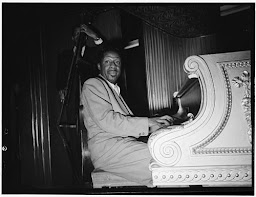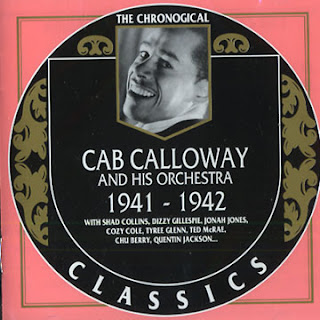Erroll Garner - The Elf
This 1976 double-LP from Arista records is a compilation of the great pianist Erroll Garner's complete sessions for Savoy from the 1940's; the sessions that were under his name anyway as Mosaic recently released a box set of Garner's music on Savoy for which he also appeared as a sideman, including a generous selection of Charlie Parker recordings. Garner was a big jazz star in the 1950s and the 1960s, spurred by his 1954 album Concert by the Sea and his most famous composition, the much maligned "Misty", but his unique approach to jazz piano was already developed on The Elf.
Garner was on his way to being a star entertainer, so his choice of material is comprised of mostly familiar standards with a few twists. His medium tempo versions of "Ghost of a chance" and "Body and Soul", normally heard as ballads, stand out. On these tracks, the swing feel created by the behind the beat phrasing in his right hand against his static left hand is astounding. It's happy but not finger-snapping on two and four-type of swing. Instead, it's tension-derived swing, kind of like when bass and drums play in a two-feel while flirting with four-four. "Body and Soul" is played with a double-time feel resulting in a longer 64-bar form.
"Misty" was a huge hit in the 1960s for Sarah Vaughan and Richard "Groove" Holmes and like "The Girl from Ipanema" and "Take Five" was largely overplayed. It was the standard nobody wanted to play and was usually said with extreme mocking disdain. Maybe because those tunes are found strictly in the domain of weddings, it seems that not many musicians hate the song as much. So I think the negative stigma of that tune might be on it's way out. Anyway, being the composer of the tune I feel like this contributed to Garner being dismissed.
Erroll Garner was born and raised in Pittsburgh and that town has cultivated some of the greatest jazz pianists including "Fatha" Earl Hines, Mary Lou Williams, Billy Strayhorn, and Ahmad Jamal. Garner had developed a most unique style of jazz piano playing of which he is the only practitioner. It sounds like an updated stride style as he plays chords in his left hand on all four beats, the way a guitarist would from the Swing era (like Freddie Green), with bass notes punctuating the off-beats. In his right hand, he played a combination of block chords, single note lines, or a combination of the two. Most of the time, his left hand.chords were played 'short' or staccato and it reinforced the swing feel. He would let the chords ring for the full duration on ballads, but often he would play like this at slow tempos creating a strong, slow swing which is not often heard anymore. The effect is like that of a big band and contributes to Garner's style being based in the Swing Era.
He was also fundamentally impacted by the blues and this comes through not only through grace notes but in his trademark technique of rolling his chords in his right hand as a way to lay back on the line. He would do this with single notes, but with one-handed chords it sounded even more powerful and contributed to his vocal-like approach to improvisation. He was known for singing along with his lines anyway (he doesn't do that on this compilation), and listening back it's clear this is his intention. The result is some of the hardest swinging jazz there is. What's incredible is listening to one hand play strict time, while the other is so far behind the beat that it sounds like two different people (he is a Gemini!). He reminds me of country blues guitarists like Robert Johnson who created a similar effect of sounding like more than one person playing the guitar. Add singing on top of it and as Keith Richards famously commented: it was like having "three brains"! Garner further differentiated the hands using dynamics as the left hand is consistently much quieter and at a consistent volume, while the right hand is dynamically expressive with a wide range from soft to extremely loud. I'm guessing that even for Garner this was difficult to do sometimes and probably an important role for the bass and drums to maintain the time in the group.
Front to back, it's a virtuosic style of piano playing and another reason why it may not have been copied extensively. But his influence is discernible on jazz pianists like Oscar Peterson, Wynton Kelly, and others.
This compilation features twenty-eight tracks, four of which were recorded in New York on September 25, 1945 while the rest were recorded in Los Angeles between March 29 and the summer of 1949. In the first session, with bassist John Levy and drummer George de Hart, Garner's style hadn't quite developed yet, playing some stride on "Stardust" and still relying solely on single note lines for his improvisations, though he does use right hand block chords here and there. Still, his very expressive style can be heard on the ballads "Stardust" and "Laura". "Laura" was a big hit and established Garner as a star. His introduction is terrific playing minor chords a minor third apart (a rarity back then). Later on his introductions would get quite dramatic and become individual pieces on their own, but in 1945 he was already conceiving of these out-of-left-field-type intros that contrasts with but segues nicely into the main theme.
On "Laura", his treatment of dissonance is particularly effective as he sets it up so well despite the sometimes jarring sounds. Besides some harmonic dissonance, on this track, he also uses the sustain pedal to blur some of the chords together. The dissonance never lasts that long, but what makes it work so effectively is that he resolves it so well. It wouldn't work otherwise. It's nice that he's this transparent with dissonance. He doesn't try to sneak anything by anyone, and by contrast he likes to announce it fully. Throughout The Elf, his diminished and dominant #5.chords are equally stamped in bright lights.
On the second set of sessions from 1949, his style is mostly in place with his right-hand mostly playing block chords, single note lines, and octaves augmented with trills. None other than the elder statesman of Pittsburgh piano, Earl Hines himself was the originator of this "trumpet style" of piano playing and Garner has made it a part of his skill set. I mentioned Garner's vocal-like approach and besides the grace notes, his use of dynamics. There is often a strong arc in his lines that are largely defined by the decrescendo at the end of his lines. I have talked here about tenor saxophonist Stanley Turrentine (another Pittsburgh native) playing in this fashion, and while it might be more natural for horn players, it's not something I associate with pianists. Garner is consistent about it too, often crescendo-ing into the end of a section and then suddenly dropping down in dynamic for the new section.
Just about every track features these devices and some of the highlights include "Penthouse Serenade", "Undecided", "Moon Glow", I'm Confessin' that I Love You", and "All of Me". Time to time he'll play two-handed chords as on "Until the Real Thing Came Along" and "Stompin' at the Savoy", but otherwise he is remarkably consistent in his approach. He is as equally expressive on his swing tunes as he is on his ballads where his left will either roll the chord in time or play long chords on the beat.
 |
| French Savoy CD compilation from 1989 |
"Goodbye" is the other standout. Written by Gordon Jenkins, this tune was famous for being the ending number for Benny Goodman. It is an unusually dark and somber song from the Swing era. Jenkins' haunting melody and dark harmonies make this a timeless composition and I'm surprised it's not played more often.
Bassist John Simmons and drummer Alvin Stoller accompany Garner and like the first session, their playing is stellar. Consummate professionals, they stay out of the way and prove to be ideal accompanists for Garner. Aside from Stoller's wonderful brush sound which comes out on the ballads and Simmons' bombs on "Red Sails in the Sunset", their playing is for the most part anonymous. Like I mentioned, I'm guessing they had to, in order to highlight their boss, Erroll Garner.







Comments
Post a Comment